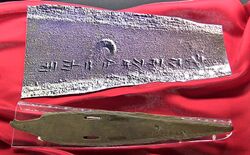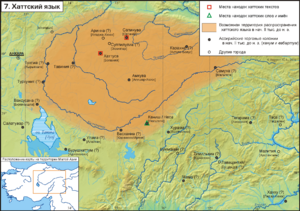أنيتـّا (ملك)
Anitta | |
|---|---|
 خنجر برونزي للملك أنيتـّا | |
| وُلِدَ | Anitta |
| السابق | پيتحانا |
| اللاحق | پيروڤا (؟) |
| الأنجال | پيروڤا وتوذاليا |
| الوالدان | پيتحانا[1] |
أنيتـّا Anitta، ابن پيتحانا Pitḫana، حكم حوالي 1740–1725 ق.م. (التأريخ المتوسط)، وكان ملك كوشـّارا، المدينة التي لم يتم التعرف عليها بعد. وهو أقدم حاكم معروف يؤلف نصاً باللغة الحيثية.[2]
المسئول الرفيع لديه، أو ربي سيمّيلتيم، كان اسمه پرووا Peruwa.[3]
السيرة
أنيتـّا، حسب التأريخ المتوسط، حكم حوالي 1740–1725 ق.م.،[4] or alternatively c. 1730-1715 BC (low middle chronology), and is the author of the Anitta text (CTH 1.A, edited in StBoT 18, 1974),[5] أقدم نص معروف باللغة الحيثية،[6] also classified as "cushion-shaped" tablet KBo 3.22,[7][8] لكونه أقدم نص معروف بلغة هندو-أوروپية على الإطلاق. ويـُعرف أيضاً بإسم أعمال أنيتـّا Deeds of Anitta، ويعتبره ألفونسو آرتشي as originally written in Akkadian language and Old Assyrian script, at the time Anitta ruled from كانش، when Assur colonies were still in Anatolia.[9] هذا النص يبدو أنه يمثل سجلاً بالمسمارية لنقوش أنيتـّا في كانش أيضاً، وربما جمعه حاتوسيلي الثالث، أحد أوائل الملوك الحيثيين على حاتوشا.
نص أنيتـّا يبين أن والد أنيتـّا فتح مدينة نشا Neša (كانش، كولتپه)، التي أصبحت مدينة هامة داخل مملكة كوشـّارا.[10] During his own reign, Anitta defeated Huzziya, the last recorded king of Zalpuwa, and the Hattic king Piyusti ثم فتح عاصمته في موقع العاصمة الحيثية المستقبلية حاتوشا. He then destroyed the city, sowed the ground with weeds,[11] and laid a curse on the site.[12]
اسم أنيتـّا يظهر في نقش على خنجر عـُثِر عليه في كولتپه وأيضاً، مع اسم والده على العديد من نصوص كولتپه، وكذلك في الموروث الحيثي اللاحق.
الحرب مع حتي وحلفاؤه وخلق دولة كوشارا

From Anitta's inscription it is known that he waged a difficult war with the kingdom of Hatti for several years. Already at the very beginning of her reign, Anitta managed to defeat the army of the king of Hatti Piyusti (Piyushti) and capture the cities of Ulamma (Akkadian Uallama), Harkiuna and others. Apparently, in the fight against Hatti, Anitta also had to break the resistance of a large coalition of the northern Black Sea regions and tribes that supported , obviously Hatti.
Among these allies of Hatti, a prominent place was occupied by the city of Tsalpuva (probably the same as Tsalpa of later sources), located near the Inner ( Black ) Sea. Anitta captured Tsalpuva, captured its king Khutsia and returned from there to Nesa , previously captured by the former king of Tsalpuva Ukhna, the statue of the Nesi deity Siusumma. Then he defeated Piusti and his allies for the second time near the city of Salampa, besieged the capital of Piusti, the city of Hattusa , and after the inhabitants were weak from hunger, he captured it.
Anitta's struggle with Hattusa and her allies was apparently so brutal that Anitta ordered the city to be razed to the ground and in his inscription solemnly cursed any future ruler who would repopulate the city he destroyed.
Anitta then captured the city of Salativara (Akkadian Shalatuara). The city of Puruskhanda also became a vassal of Anitta , whose ruler gave Anitta his most valuable things - an iron throne and a scepter (iron during almost the entire 2nd millennium BC was, as is known, the most precious of metals). It is important to note that, presumably, the ruler of Puruskhanda previously exercised hegemony in the central part of Asia Minor.
Anitta made the city of Nesu his main residence (after the name of this city the Hittites later called their language Nesitic). In Nes he built temples to the gods Siusumma and Halmasuitta and created a menagerie for the royal hunt.
الانتماء العرقي الثقافي لحكام كوشار
Some historians would like to see Pithana , Anitta and his son Piruva as non-Indo-Europeans. Based on this, they hypothesized that although Anitta’s inscription was written in the Nesith language, Anitta himself might not have been a Nesit. A version was also put forward that Anitta’s inscription could initially have been composed in the Hatti language and only later was it allegedly translated into Nesith. As proof of this, it was pointed out that the god Siusumma (Siu[na]summis) repeatedly mentioned in the inscription is only a non-Sith stable phrase “my god” (siunas-mis) . It was further suggested that Anitta and his scribes “poorly knew” the Nesith language and therefore mistakenly took the expression for the personal name of the patron god of the city of Nesa. As an argument, the fact was also cited that the god Halmasuitta, who in Anitta’s inscription appears as the deity of the king himself and, probably, the patron god of the city of Kussar , was in origin a deity of Hatti . His name is apparently derived from the Hattian ha-nuasu-it - "royal throne" - that is, "deity of the royal throne."
However, all these ideas only complicate the understanding of ancient sources, confusing their interpretation. In fact, the Nesi Hittites , Indo-European in language, were for a long time under the sociocultural influence of first the Hutts and then the related Hurrians . The civilization of Asia Minor as a whole was constantly under the powerful influence of Akkadian - Sumerian Mesopotamia . And, accordingly, the Hittites constantly used - as prestigious - non-Indo-European names, religious cults, examples of written texts, industrial and military-political terms.
مملكة كوشار
The Kussar kingdom created under Anitta was the most powerful political unity that existed in Central Asia Minor before the formation of the Hittite state . Anitta owned a significant territory and, in any case, exercised hegemony from Lake Tuz to the passes through the Taurus Minor , including a large territory inside the bend of the Galis River . But in Anitta’s state the vestiges of the tribal system were still strong.
Evidence has also been preserved of the size of Anitta’s army. These are 40 chariots and 1400 infantry. [1] During the excavations of Kanish, a dagger with the name of Anitta was found, and at the site of Alishar (possibly the ancient city of Amkuva ) - a document mentioning the “great ruler” Anittas and his “chief of the ladder” (that is, co-heir to the throne) Piruva (Perva).
انظر أيضاً
المراجع
- ^ "Reign of Anitta", Hittites
- ^ Gonnet-Bağana, Hatice, (2015). "Anitta, CTH 1-30 (Proclamation of Anitta of Kussar) - CTH 1", Koc Universitesi Digital Collections.
- ^ Klaas R Veenhof (2008). Mesopotamia: The Old Assyrian Period. Vandenhoeck & Ruprecht. p. 145.
- ^ Kloekhorst, Alwin, (2020). "The Authorship of the Old Hittite Palace Chronicle (CTH 8): A Case for Anitta", in Journal of Cuneiform Studies, Volume 72 (2020).
- ^ Didact, DE: Uni. Frankfurt, http://titus.uni-frankfurt.de/didact/idg/anat/hethbs.htm.
- ^ Gonnet-Bağana, Hatice, (2015). "Anitta, CTH 1-30 (Proclamation of Anitta of Kussar) - CTH 1", Koc Universitesi Digital Collections: "...Analytical commentary on the Anitta text (CTH 1.A, edited in StBoT 18, 1974), أقدم نص تاريخي أصلي يُعثَر عليه في بوغازكوي وأقدم نص معروف باللغة الحيثية. تأليف النص يُنسب إلى أنيتـّا، ابن پيتحانا وملك كوشـّارا...الذي يظهر اسمه في نقش على خنجر عُثر عليه في كولتپه. Emmanuel Laroche classifies this tablet in the category of historical texts prior to the imperial period (Catalogue des textes Hittites, No. 1)..."
- ^ Kloekhorst, Alwin, and Willemijn Waal, (2019). "A Hittite scribal tradition predating the tablet collections of Ḫattuša?: The origin of the ‘cushion-shaped’ tablets KBo 3.22, KBo 17.21+, KBo 22.1, and KBo 22.2.", in: Zeitschrift Für Assyriologie Und Vorderasiatische Archäologie, 109(2), p. 190: "...KBo 3.22 (the Anitta-text, CTH 1)..."
- ^ Yakubovich, Ilya, (2017). "The Luwian Title of the Great King", in: Hittitology Today: "...Finally the Deeds of Anitta in the Hittite language also refer to him once as LUGAL.GAL (KBo 3.22 obv. 41)..."
- ^ Rieken, Elisabeth, and Ilia Yakubovich, (2023). "Encounters between Scripts in Bronze Age Asia Minor", in: Seen Not Herad, Ilona Zsolnay (ed.), pp. 205-235, p. 207: "...Archi (2015) plausibly argues that this text [Deeds of Anitta] was originalllly composed in the Akkadian language and written down in the Old Assyrian script during the time when أنيتـّا، الملك الأناضولي الأصل حكم كانش/نشا بينما كانت المستعمرات التجارية الآشورية تواصل العمل في الأناضول."
- ^ Kuhrt, Amélie (1995). The Ancient Near East, Volume I. London and New York: Routledge. pp. 226–27. ISBN 0-415-16763-9.
- ^ S. P. B. Durnford, J. R. Akeroyd: Anatolian marashanha and the many uses of Fennel. In: Anatolian Studies. London 55.2005, 1-13. ISSN 0066-1546
- ^ William James Hamblin (2006). Warfare in the Ancient Near East to 1600 BC. Routledge. p. 293..
وصلات خارجية
- The Anitta text
- The Hittite occupation of Anatolia[Usurped!]
- Kültepe-dagger inscription
- Reign of Anitta
| سبقه پيتحانا |
ملك حيثي ح. القرن 18 ق.م. |
غير معروف آخر حامل معروف للقب: توذاليا (؟)
|
